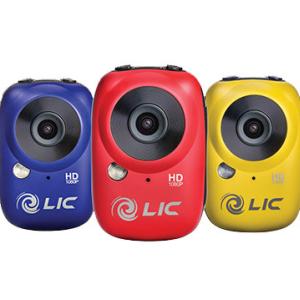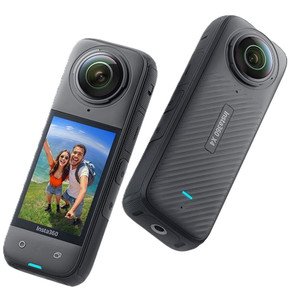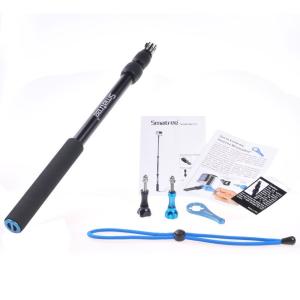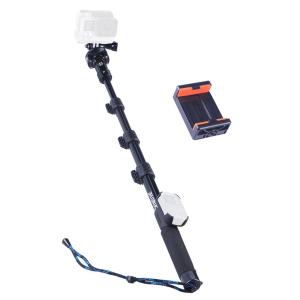Sony Action Cam HDR-AS30V
(discontinued)
| Where To Buy | |||
|---|---|---|---|
Free shipping on orders over $50 (continental U.S. only).
International shipping available. Some exclusions apply. |
|||
Free shipping on orders over $50 (continental U.S. only).
International shipping available. Some exclusions apply. |
|||
Review and video by Johan Hjord // Photos by Tal Rozow and Johan Hjord
When big dog Sony entered the POV camera market a bit more than a year ago, a lot of people were rightfully excited. Sony has a long history of producing world-class video cameras, and the Action Cam (HDR-AS15V) looked like it ticked a lot of POV boxes in addition to bringing some innovative new features to the table. We reviewed that first camera, and though we found it very impressive in some aspects, there were some issues that knocked its score down a bit. Fast-forward to today and there's a new, updated AS30V Action Cam. We have been testing it to see if Sony has managed to iron out some of the bugs and ultimately whether it is a viable contender in a market still dominated by GoPro.

AS30V Highlights (Live View Remote Bundle)
- SteadyShot image stabilization
- Wi-Fi and NFC for remote control and smartphone viewing
- GPS plots location and calculates telemetry
- 6 video modes including 1080/60p HD and 4x slo mo
- Ultra-wide 170° Carl Zeiss Vario-Tessar lens
- Exmor R CMOS sensor for low light performance
- Rugged, waterproof housing with universal tripod mount
- Included Live-View Remote for hands-free remote control and viewing
- Built-in stereo mic
- Mac and PC-compatible
- MSRP: $399 USD (live view remote bundle), $269 USD (Action Cam only)
Initial Impressions
Out of the box, the AS30V looks very similar to the original Action Cam, and with the same quality material and workmanship throughout. It ships with fewer mount options included in the basic kit than GoPro does (notably absent is a tilting helmet mount), although we also received a few extra accessories to test the camera with. Two things jump out at you when you put it side by side with the first generation of the camera – it seems much smaller, and it has more buttons on the housing.

Regarding the size, the camera body itself is actually identical in form factor to the old one, but the new housing is significantly slimmer. Sony decided that making the standard housing waterproof down to five meters (16 feet) would be enough, and in doing so they were able to make a significantly smaller case that also features a thin microphone membrane that allows for proper sound capture even with the housing on. Note that a dive case which is rated to 200 feet and features a flat port for sharp underwater footage is also available. The lower waterproof rating also allowed Sony to include two slim buttons on the side, which means we are finally able to access all camera functions even with the camera in the housing (this was not the case with the first generation housing). Because the two generations of cameras are the same form factor, all your old Action Cam accessories will work with the new one, which is nice.

Sony have kept all of the cutting edge features introduced on the first Action Cam, like SteadyShot, hi-FPS super slo-mo recording modes, and built-in WiFi. In addition, they have introduced GPS on the AS30V, which allows for the capture of GPS data alongside the video being recorded. Another novelty is the introduction of a 1080/60fps recording mode with high bitrate and the ability to record sound – the previous generation only offered the 60fps mode without sound, but there is also a firmware update available for the older generation which includes the new recording modes and other improvements – a nice touch for owners.
Continuing the feature tour, we note that the camera now takes stills at 12MP, a huge improvement on the original cam which could only muster a meekly 2MP, and it also has a new option for controlling the tone of the image. There are 2 “Scene” modes available, Normal and Water.
Our bundle included the Live View Remote, which is a small device that connects to the Action Cam via WiFi and then allows you to control the camera remotely, as well as preview what the camera sees before and during recording. The remote is splashproof but not waterproof.

The Action Cam can take a couple of different types of standard Sony rechargeable batteries (it ships with the highest capacity one), which is great – easy to bring a spare for long days of shooting, and if you already own Sony cameras, you may already have a battery that will work for the Action Cam as well.
On The Trail And Everywhere Else
The Action Cam is operated via three buttons, a main on/off button that also acts as the “Enter” button while navigating through the in-camera menu settings, and two navigational “Prev” and “Next” buttons. The menu system is reasonably well-thought out and easy to navigate through, with no real hidden options or hard-to-get-to tweaks. The built-in LCD is small but informative (it is only used for displaying settings and menus), and it is always easy to tell what recording mode you are in and if you are recording or not. Some of the options could do with easier to read short codes though.

If you turn the camera on via the main Start/Stop switch, it starts up and immediately begins recording. This is good if that is what you wanted to do, however if you just wanted to turn the camera on, then you’ll have to stop recording immediately and you’ll have a bunch of little one second clips at the end of the day. If you use either of the other two buttons to turn the camera on, it powers up without starting to record.
It is simple to choose a recording mode, although note that not all combinations of modes are possible. Because the SteadyShot is electronic and functions by cropping the image on the sensor and then moving it around to counter camera shake, it cannot operate when using the 170-degree wide angle field of view (because the whole sensor is used for the image capture in this case). SteadyShot is also not available in 120FPS super slomo, presumably because of the available computing power being monopolized to record at that frame rate. The field of view restriction is less of an issue in reality, because the wide angle of view is inherently less sensitive to camera shake, but it is one to keep in mind when choosing to record in super slomo mode – best used for trail side shots with steady hands or a tripod.
One of the issues with cameras that lack a viewfinder is getting the setup on the helmet/chest/wherever right. The Live View Remote came in very handy here. Power up the cam and the remote, and after a few seconds you can see what the camera sees on the screen of the remote. You can also access many of the settings and functions of the camera via the remote, so it’s easy to change settings without removing your helmet for example. If you do not have the remote, Sony provide the “PlayMemories” app for iPhone or Android for free. This app provides the same functionality as the Live View Remote on your smartphone.
Note that using WiFi tends to heat up the camera significantly, and because WiFi won’t allow the Action Cam to shut down between takes either, leaving it on can cause condensation to build up in the case, especially on colder, humid days. Make sure to turn the camera off manually between runs to prevent this from becoming an issue. Sony also sells anti-fog sheets which are inserted into the housing to prevent moisture build-up.

The Live View Remote works well enough for controlling the camera and setting up shots, and is comfortable to wear even for extended periods of time. We did however experience a lot of dropped connections during actual recording. This does not affect the outcome, as the camera continues to record even after dropping the connection with the remote, but it is nonetheless not very impressive for a $169 accessory. To re-establish the connection you turn the remote off and back on again. We noticed similar issues with the iPhone app, dropped connections a little too frequently. We did apply a firmware update to the Action Cam in the hope that it might address this issue, but to no avail.
A year after introducing the original Action Cam, Sony have finally caught up to GoPro and provide a chest mount for the AS30V. While the whole set up ends up a bit bulkier than the GoPro version because the Sony is elongated in shape, the chest harness does feature a breakaway mount which allows the camera to release if you crash. Also note that you don’t have to flip the Action Cam footage as this chest mount holds the camera in the normal position, and allows for an almost unlimited angle of adjustment in all directions.

The chest mount proved excellent in operation, and coupled with the image stabilization of the Action Cam it produces a very immersive experience, keeping enough shake and movement in the image to maintain a sense of action, but maintaining the trail steady on the screen. This quickly became our favorite way of filming with the Action Cam. When helmet mounted, footage produced with SteadyShot on is unnaturally smooth and takes away from the trail experience, unless you are following another rider in which case it provides a great way of focusing on that rider without the distraction of camera shake.

We also received a new “tube mount” to try out. It’s meant to allow you to mount the Action Cam to anything tube shaped, and it includes two different lengths of strap to cater to different tube sizes. While an improvement on Sony’s original handlebar mount (which was woefully inadequate – ours developed severe play after only one ride, which then happened again on the replacement unit), this new version is still not a good accessory for mountain biking. Because its base is essentially made of rubber, it generates a lot of camera wobble and shake as soon as you roll out. We had moderate success when mounting it on a vertical tube (upper stanction, seat tube), but this accessory is best used for attaching your Action Cam to something a lot less prone to actually moving around than a mountain bike…
Video
The most important aspect of any video recorder is the result – your clips and edits. The Sony has improved in many areas, and we were quite impressed with the video quality of the HDR-AS30V:
Various clips shot with the Sony Action Cam HDR-AS30V
SteadyShot is very good. It is by far the most effective way of stabilizing POV video we have ever seen, superior to wide angles and similar tricks. When mounted on a helmet, it produces very smooth results – so smooth that it is almost unnerving, especially if you are used to the shaky images produced by other cameras. When used together with a chest mount, we found the footage to be the most immersive to date, almost up there with the quality often seen in major productions where lots of tricks are usually employed to achieve such results. Bit of a game changer here.
The super slow motion mode is excellent and produces 4X slomo that is very smooth. Note that you lose audio at 120fps, which is a bit annoying but probably not a deal-breaker. If you do want audio with slomo, use the 1080/60fps mode which allows you to slow down footage 2x, and still retain audio.
Audio is well controlled, and sounds a bit less “boxy” than we have become accustomed to on other POV cameras. The new waterproof housing muffles the sound a little bit of course, but it is still audible and usable.
The first generation of the Action Cam used far too much compression on the video files it produced. The addition of new video modes and presumably revisions to firmware on the new version have by and large addressed this issue. Comparing the AS30V to the GoPro Hero 3+ Black Edition, there is a not a lot of difference between the two on identical settings. Check the two clips below, each one filmed on the same section of trail within 10 minutes of each other, in 1080/60fps mode on the widest angle without image stabilization. Straight out of the camera, the GoPro files do seem to hold a slight edge in terms of overall crispness of image, but as soon as things start moving, it’s Even Steven, pretty much.
Sony Action Cam HDR-AS30V Reference Clip:
GoPro Hero 3+ Black Edition Reference Clip:
The following screen grabs show slightly more visible compression artifacts from the Sony footage, which is probably due to compression algorithms, optics, and the difference in bitrate (30Mbps on the GoPro vs “only” 25Mbps on the Sony, in this recording mode). We were also pleased to note that the turquoise hue present on the first generation of the Action Cam (especially in the sky) is all but gone now, although the image is still notably colder than GoPro.
Sony HDR-AS30V:

GoPro Hero 3+ Black Edition:

Viewing the built-in GPS data from the Action Cam requires use of Sony’s “PlayMemories Home” software, which allows you to create an overlay of speed, location, and map data on top of the video footage captured. It works OK, although it is a bit unwieldy to operate. There also appears to be some lag and inaccuracies in the GPS data captured, and we wouldn’t have too much faith in the speed readings it generates when riding twisty trails. Nevertheless, it's a fun feature, and one that could potentially be very useful for analyzing training rides/race runs.

Things That Could Be Improved
The new housing is a great improvement with its slimmer size and new external buttons. However, those buttons are not very easy to operate. They feature raised ridges to prevent unwanted operation, which is of course a good thing, but we think they could be made slightly easier to operate without losing this aspect.
The Live View Remote is a useful addition to Action Cam, but we’d like to see it function without the hiccups. It never caused us to lose footage, but it should not have to drop the connection with the camera so often.
The Action Cam does not offer a lot of control over image quality aspects like white balance. Sony have certainly improved both the quality and the look of footage from the Action Cam, but they still lag behind GoPro in terms of user image control.
We’d like to see more accessories out of the box – notably the fact that you have to buy a tilting adaptor for your helmet mount separately is a little bit on the cheap side. The Sony is priced directly in line with GoPro, and yes the remote does offer live view which the GoPro remote does not, but at least a tilting helmet mount is really a must.
Sony are catching up in the mount game, notably with the long overdue addition of a chest mount. It still has some way to go to produce a proper tube mount though.
The small red LED that indicates that you are recording is all but useless in daylight. You do have the built-in LCD screen to fall back on to check if you are indeed recording, but still, this could have been done better. Also, the audible “beep” and “bee-bee-beep” to indicate starting and stopping recording are not loud enough. Iin fact they are significantly LESS loud than on the first generation of the Action Cam, which we already found too soft.
Long Term Durability
We've owned the original Action Cam since it came out over a year ago, and it has seen a lot of use during that time. It is none the worse for wear. Even the plastic housing while scuffed up and generally a bit sorry looking has not missed a beat - it is still waterproof, and the viewport is still clear enough to produce good footage. There are no bits that look like they want to fall off the camera, nor are any of the buttons acting up. The interface between the base and the helmet mount is as slop-free as on day one, and the mounts we glued to our helmets are still there. The battery still holds a good charge too. After using the new version for two months, we have no reason to believe it will not offer the same durability as the older generation, which should translate to years of trouble-free filming ahead. The same cannot be said for the tube mounts offered by Sony, both versions have proven all but useless for mountain biking, due to how quickly they develop play (out of the box, basically).
What’s The Bottom Line?
With the HDR-AS30V Action Cam, Sony has all but caught up to GoPro in terms of image quality, at least when recording in the highest quality settings. It is also mostly evenly matched with the GoPro in terms of features, but has an edge when it comes to image stabilization, the Live View Remote, and the built-in GPS. Add a growing ecosystem of mounts and the Action Cam is poised as a serious threat to GoPro. There is also a new version of the Action Cam due to hit stores in April which will offer pro-level image quality at the same price, but unless you think you have a need for 50 Mbps footage, the AS30V is a solid investment. Sony also seems set to stick with the form factor between generations, which means you can splash out on accessories without fear of having to replace them all down the line.
For more details, visit Sony.com.
About The Reviewer
Johan Hjord loves bikes, which strangely doesn’t make him any better at riding them. After many years spent practicing falling off cliffs with his snowboard, he took up mountain biking in 2005. Ever since, he’s mostly been riding bikes with too much suspension travel to cover up his many flaws as a rider. His 200-pound body weight coupled with unique skill for poor line choice and clumsy landings make him an expert on durability - if parts survive Johan, they’re pretty much okay for anybody. Johan rides flat pedals with a riding style that he describes as "none" (when in actuality he rips!). Having found most trail features to be not to his liking, Johan spends much of his spare time building his own. Johan’s other accomplishments include surviving this far and helping keep the Vital Media Machine’s stoke dial firmly on 11.
Specifications
• SteadyShot™ image stabilization
• Wi-Fi and NFC for remote control and smartphone viewing
• GPS plots location and calculates telemetry
• 6 video modes including 1080/60p HD and 4x slo mo
• Ultra-wide 170° Carl Zeiss® Vario-Tessar® lens
• Exmor R® CMOS sensor for low light performance
• Rugged, waterproof housing with universal tripod mount
• Included Live-View Remote for hands-free remote control and viewing
• Built-in stereo mic
• Mac® and PC-compatible
• MSRP: $399 USD (live view remote bundle), $269 USD (Action Cam only)
| Where To Buy | |||
|---|---|---|---|
Free shipping on orders over $50 (continental U.S. only).
International shipping available. Some exclusions apply. |
|||
Free shipping on orders over $50 (continental U.S. only).
International shipping available. Some exclusions apply. |
|||






























1 comments
Post a reply to: Tested: Sony Action Cam HDR-AS30V